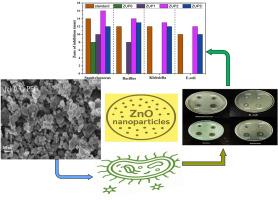共沉淀法合成聚乙二醇功能化氧化锌纳米颗粒以提高抗菌性能
IF 3.4
4区 化学
Q2 CHEMISTRY, MULTIDISCIPLINARY
引用次数: 0
摘要
氧化锌纳米颗粒(ZONPs)由于其强大的抗菌性能而在生物医学应用中引起了广泛的关注,这主要归功于它们能够产生活性氧并与微生物膜相互作用。本研究采用共沉淀法合成ZONPs,然后用尿素和多种聚乙二醇对其进行改性,以增强其理化性能和抗菌性能。系统研究了不同PEG浓度(0.1、0.3和0.5 g)对ZnO结构、形态、光学性质及其抗菌效果的影响。通过x射线衍射、拉曼光谱、EDX场发射扫描电子显微镜(FESEM)和紫外可见光谱进行了结构、形态和光学表征。采用琼脂孔法测定其抑菌效果。合成的ZONPs具有良好的结晶度,其表面修饰受PEG含量的影响。在不同的PEG负载中,与使用0、0.1和0.5 g PEG制备的样品相比,使用0.3 g PEG制备的样品具有更好的表面形貌和更高的ROS生成。1 mg/mL对葡萄球菌、芽孢杆菌、克雷伯氏菌和大肠杆菌的抑制区分别为16 mm、14 mm、13 mm和12 mm,具有广谱活性。本文章由计算机程序翻译,如有差异,请以英文原文为准。

PEG-functionalized ZnO nanoparticles synthesized by Co-precipitation for improved antibacterial performance
Zinc oxide nanoparticles (ZONPs) have attracted substantial attention in biomedical applications because of their potent antibacterial properties, primarily attributed to their ability to generate reactive oxygen species and interact with microbial membranes. In the present research work, ZONPs were synthesized using the co-precipitation method and subsequently modified with urea and varied polyethylene glycol to enhance their physicochemical and antibacterial properties. The influence of varying PEG concentrations (0.1, 0.3, and 0.5 g) on the structural, morphological, and optical properties, and their antibacterial efficacy of ZnO was systematically investigated. Structural, morphological, and optical characterizations were performed through X-ray diffraction, Raman spectroscopy, Field emission scanning electron microscopy (FESEM) with EDX, and UV–Visible spectroscopy. The antibacterial efficacy was measured by using Agar well method. The synthesized ZONPs exhibited well-defined crystallinity with surface modifications influenced by PEG content. Among the different PEG loadings, the sample prepared with 0.3 g PEG showed improved surface morphology and higher ROS generation compared to those obtained with 0, 0.1, and 0.5 g PEG. Antibacterial assessment at 1 mg/mL revealed inhibition zones of 16 mm against Staphylococcus, 14 mm against Bacillus, 13 mm against Klebsiella, and 12 mm against E. coli, indicating effective broad-spectrum activity.
求助全文
通过发布文献求助,成功后即可免费获取论文全文。
去求助
来源期刊
CiteScore
3.50
自引率
7.70%
发文量
492
审稿时长
3-8 weeks
期刊介绍:
The Journal of the Indian Chemical Society publishes original, fundamental, theorical, experimental research work of highest quality in all areas of chemistry, biochemistry, medicinal chemistry, electrochemistry, agrochemistry, chemical engineering and technology, food chemistry, environmental chemistry, etc.

 求助内容:
求助内容: 应助结果提醒方式:
应助结果提醒方式:


